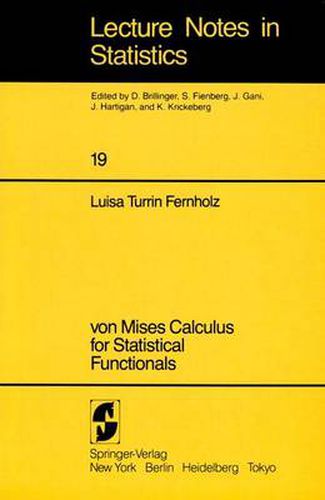Readings Newsletter
Become a Readings Member to make your shopping experience even easier.
Sign in or sign up for free!
You’re not far away from qualifying for FREE standard shipping within Australia
You’ve qualified for FREE standard shipping within Australia
The cart is loading…






This title is printed to order. This book may have been self-published. If so, we cannot guarantee the quality of the content. In the main most books will have gone through the editing process however some may not. We therefore suggest that you be aware of this before ordering this book. If in doubt check either the author or publisher’s details as we are unable to accept any returns unless they are faulty. Please contact us if you have any questions.
About forty years ago, Richard von Mises proposed a theory for the analysis of the asymptotic behavior of nonlinear statistical functionals based on the differentiability properties of these functionals. His theory was largely neglected until the late 1960’s when it experienced a renaissance due to developments in the field of robust statistics. In particular, the Volterra derivative used by von Mises evolved into the influence curve, which was used to provide information about the sensi- ti vity of an estimator to outliers, as well as the estimator’s asymptot- ic variance. Moreover, with the Princeton Robustness Study (Andrews et al. (1972)), there began a proliferation of new robust statistics, and the formal von Mises calculations provided a convenient heuristic tool for the analysis of the asymptotic distributions of these statistics. In the last few years, these calculations have been put in a more rigorous setting based on the Frechet and Hadamard, or compact, derivatives. The purpose of these notes is to provide von Mises’ theory with a rig- orous mathematical framework which is sufficiently straightforward so that it can be applied routinely with little more effort than is required for the calculation of the influence curve. The approach presented here is based on the Hadamard derivative and is applicable to diverse forms of sta- tistical functionals.
$9.00 standard shipping within Australia
FREE standard shipping within Australia for orders over $100.00
Express & International shipping calculated at checkout
This title is printed to order. This book may have been self-published. If so, we cannot guarantee the quality of the content. In the main most books will have gone through the editing process however some may not. We therefore suggest that you be aware of this before ordering this book. If in doubt check either the author or publisher’s details as we are unable to accept any returns unless they are faulty. Please contact us if you have any questions.
About forty years ago, Richard von Mises proposed a theory for the analysis of the asymptotic behavior of nonlinear statistical functionals based on the differentiability properties of these functionals. His theory was largely neglected until the late 1960’s when it experienced a renaissance due to developments in the field of robust statistics. In particular, the Volterra derivative used by von Mises evolved into the influence curve, which was used to provide information about the sensi- ti vity of an estimator to outliers, as well as the estimator’s asymptot- ic variance. Moreover, with the Princeton Robustness Study (Andrews et al. (1972)), there began a proliferation of new robust statistics, and the formal von Mises calculations provided a convenient heuristic tool for the analysis of the asymptotic distributions of these statistics. In the last few years, these calculations have been put in a more rigorous setting based on the Frechet and Hadamard, or compact, derivatives. The purpose of these notes is to provide von Mises’ theory with a rig- orous mathematical framework which is sufficiently straightforward so that it can be applied routinely with little more effort than is required for the calculation of the influence curve. The approach presented here is based on the Hadamard derivative and is applicable to diverse forms of sta- tistical functionals.